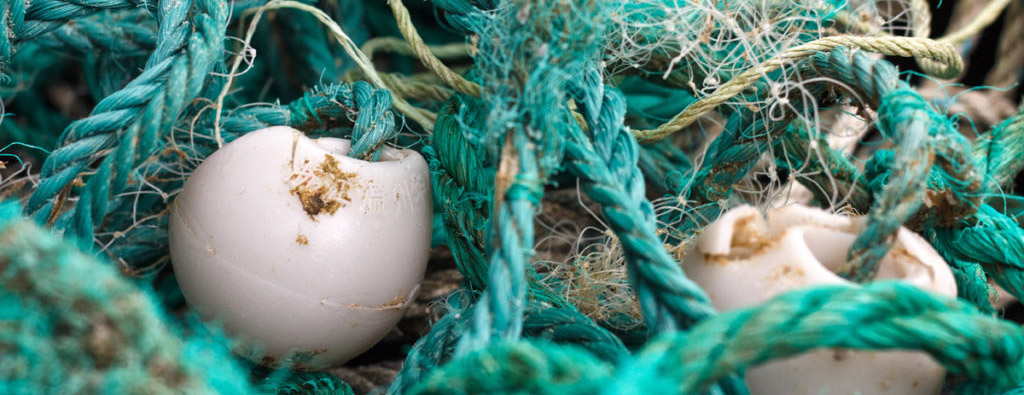history

Ghost net is one of the most abundant and dangerous sources of plastic marine debris in our oceans.
This lost or abandoned fishing gear makes up 46% of the mass in the Great Pacific Garbage Patch, where it entangles wildlife and disintegrates into microplastics, affecting every level of the food web and marine ecosystem.
Since 2015, I have created machine-stitched baskets from fishing rope washed up on the coastlines of Oregon, Kauai, and Maine. The collection site of each rope tells its own unique story about the effects of coastal industry on local and global scales.
In 2018, I pulled rope from a massive environment created from two tons of ghost net, hauled off Kauai's beaches by Surfrider Kauai in just two months.
This experience directly inspired the Ghost Net Landscape installation. I envisioned bringing the pile into public creative spaces to reframe its powerful physical presence - a small fraction of what washes ashore every day - beyond a problem, into the realm of possibility.
What happens to the material after it is removed from the ocean is a work in progress. Worldwide, companies are melting down ocean plastic for re-use in products like skateboards, shoes, and building bricks. Some places incinerate it in waste-to-energy facilities. And more and more artists are taking advantage of marine debris in their work! Check out Splash Trash on Instagram for over 200 artists making incredible art with marine debris worldwide!
project timeline
lessons from the sea
My relationship with this material began with joy.
Washed-up bits of fishing gear were one of my beachcombing treasures, long before I knew this was a global environmental issue. I saw the ocean’s story told in each weathered piece of rope, frayed by the waves, knotted into sculptural forms, each hosting an ecosystem of kelp and barnacles. Every piece was unique. How many years, how many thousands of miles had it traveled? Each story was another thread connecting us to the sea, a visual reminder of resilience, rebuilding, and transformation. There is no waste in the natural world, only transformation. The work of waves and weather on discarded fishing gear reframes the material from 'waste' into potential and possibility. Ghost Net Landscape illuminates these transformations, and invites each of us to contribute our own future-focused solutions. That is the first lesson I learned, from the collaboration of materials with the sea. I learned it at my grandparents’ home in the lobster-fishing town of Deer Isle, Maine.
GHOST NET
The second lesson I learned on Kauai, the island where I grew up. On Kauai I encountered a true landscape of ghost net, a massive environment weighing tons, all collected from local beaches by Surfrider beach cleanup volunteers. In this soft-sculpture landscape, face to face with the magnitude of the issue, I learned the essential value of open-hearted collaboration. My ongoing experience with Surfrider Kauai's generosity and vision is best described through two traditional Hawaiian values: aloha and pono. Aloha is welcoming and generous. Pono is our honor and responsibility to do what is right. These values are enacted in our decisions not once, but continually. Combining them together is a powerful experience: justice with generosity, and welcoming with responsibility. In healing our future, we cannot forget aloha and generosity as we pursue what is pono, what is right. And we cannot forget what is right, as we show aloha and welcoming.
FISHERMEN’S STORY
In early 2019, I began coordinating the first installations of Ghost Net Landscape in public spaces near my home in the Portland, Oregon metro area. I was determined to re-create my Kauai experience with the massive pile of materials and share it as an art installation. I spent two months reaching out to fisheries and beach cleanup crews in Oregon and Washington to find local sources of material. During this time, I learned so much about responsible fisheries who want to make sure their end-of-life gear never becomes ghost net, and who hope it can find a better future than the landfill.
FUTURE
Each partnership with beach cleanup crews and fisheries teaches me more about the many ways our communities interact with this material. I'm currently seeking partnerships to travel the project to new locations around the world. I'm excited to work with venues, funders, and local cultural and industry groups to connect and learn from new communities! Click here to learn more about hosting Ghost Net Landscape in your community.
© 2025 Emily Jung Miller fine art - Ocean-inspired artwork from Oregon & Kauai.
